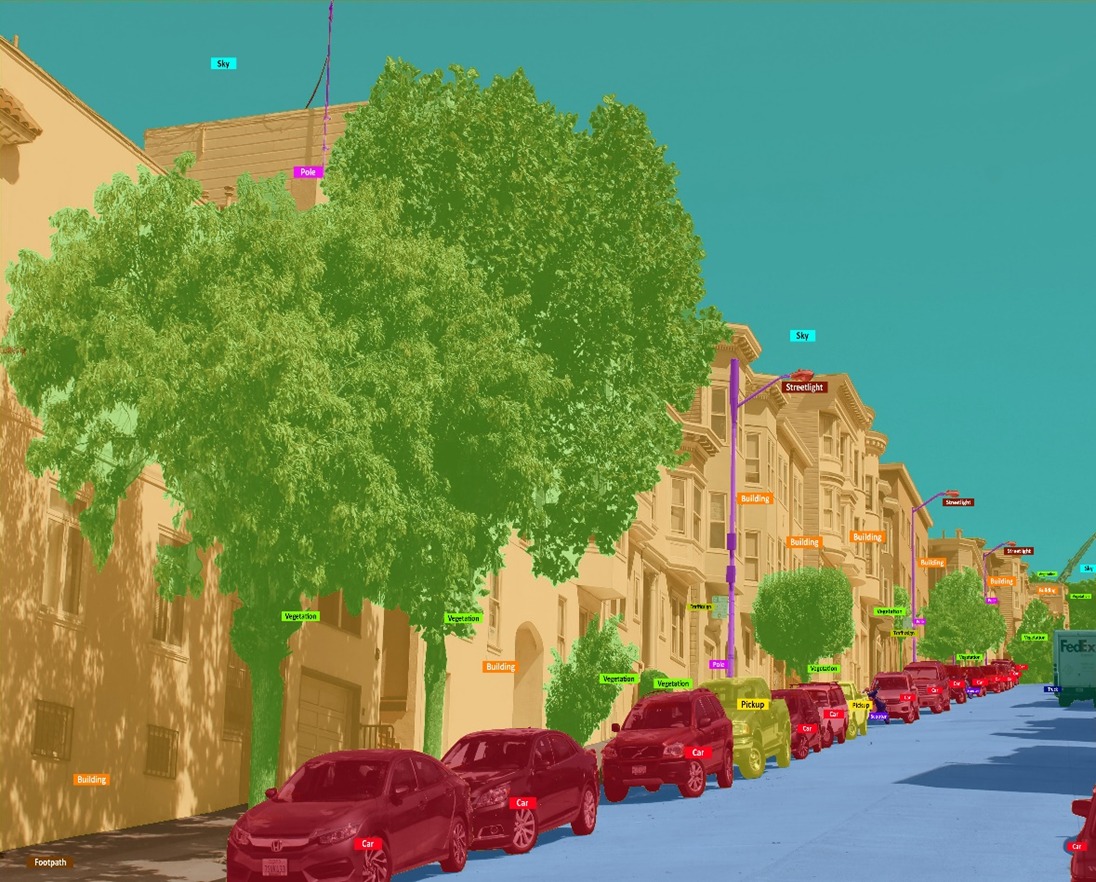The Role of Data Labeling for Autonomous Vehicles
 Infolks
Infolks
Even the most skilled human drivers sometimes struggle to navigate the complexities of the road. Then how can a driverless vehicle run on the road? How do they reach their destinations safely? Autonomous vehicles rely on AI algorithms that enable them to identify and handle everything a human driver can. They learn from vast amounts of training data, which plays a crucial role in their navigation. Data labeling, the process of annotating training data for autonomous vehicles, is integral to their development. In this blog, we will take a look at the role of data annotation in developing autonomous vehicles.
How Autonomous Vehicles Are Operating?
First, we need to understand how an autonomous vehicle operates and the processes it goes through from starting to reaching its destination.
Autonomous vehicles operate through the integration of various sensors, algorithms, and control systems, allowing them to navigate and function without human intervention. Autonomous vehicles are equipped with a variety of sensors, including LiDAR, radar, cameras, and ultrasonic sensors. These sensors continuously scan their surroundings to detect nearby objects such as vehicles, pedestrians, and road obstacles. Simultaneously, onboard computers process this sensor data to create a detailed perception of the environment, involving object detection, classification, and tracking to identify and locate objects around the vehicle before starting.
Once a path is planned, the vehicle's control system adjusts the steering, acceleration, and braking to follow the planned trajectory while adhering to traffic rules and safety constraints. Additionally, high-definition maps of the vehicle's operating area are often preloaded into the system, providing detailed information about road geometry, lane markings, traffic signs, and other relevant features. As the journey progresses, the autonomous vehicle continuously updates its perception of the environment, reevaluates its path, and adjusts its trajectory accordingly. These vehicles are programmed with decision-making algorithms that enable them to react to changing traffic conditions, unexpected obstacles, and other unpredictable events such as animals crossing or wrong-side entries.
The Role of Data Labeling
Data labeling involves annotating or tagging raw data to make it understandable and usable for machine learning algorithms. The relationship between autonomous vehicles and data labeling is fundamental, as the vehicle, equipped with AI algorithms, is built upon this foundation. Just as we learn from experience, labeled data teaches autonomous vehicles to identify objects, navigate complex situations, and make safe decisions on the road.
For instance, consider a scenario where a pedestrian crosses the road. The vehicle, through its AI algorithms, recognizes this as a pedestrian crossing situation and determines that it's time to slow down or stop. This awareness stems from the vehicle learning from various types of traffic-related labeled data. Every labeled instance of pedestrian crossings, along with other traffic scenarios, contributes to the vehicle's ability to perceive and respond appropriately in real-time situations. Understand more about data labeling for autonomous vehicles from scratch in the next section.
What Data is Used for Autonomous Vehicles?
We discussed above that self-driving cars are equipped with a suite of sensors that capture real-world data during testing and operation. The data captured by these sensors includes images, videos, 3D LiDAR data, etc., providing a comprehensive understanding of the vehicle's environment. It contains information about vehicles, pedestrians, traffic signs, and road conditions. It needs to be labeled for the AI to identify and understand the elements it's seeing.
What Objects Are to Be Labeled?
We discussed that sensors capture data for understanding of their surroundings. However, not all details or information in this data are needed for autonomous vehicles, such as an advertisement poster on the wall or a human depicted in the advertisement poster. Therefore, we have to label only the necessary information in the data. Some of the key objects annotated for autonomous driving are explained here.
Pedestrians: Annotating pedestrians including adults, children, and animals, walking, running, or standing near or crossing roads.
Cyclists: Annotating cyclists riding on roads or bike lanes to help autonomous vehicles detect and predict their movements, ensuring safe interaction with cyclists.
Traffic Signs: Annotating traffic signs such as stop signs, yield signs, speed limit signs, traffic lights, and other regulatory signs to assist in interpreting traffic regulations and obeying traffic laws.
Road Markings: Annotating road markings, including lane boundaries, lane dividers, crosswalks, and other pavement markings, to aid in lane detection, lane keeping, and path planning tasks.
Obstacles: Annotating various obstacles on the road, such as debris, construction barriers, parked vehicles, and other obstructions, to help autonomous vehicles navigate safely around them.
Structures and Landmarks: Annotating buildings, trees, streetlights, bridges, and other structures or landmarks to help the vehicle understand the layout of the environment and navigate accurately.
By annotating only the key elements or objects, AI can differentiate between a pedestrian and a person's image in the poster, a vehicle on the road, and the vehicle image in the poster, etc.
How to Get Labeled Data?
Primarily, three methods are commonly used for obtaining labeled data for AI training: in-house labeling, crowdsourcing, and outsourcing. Regardless of the method used, data labeling primarily occurs in two ways: automated and manual data labeling. For autonomous vehicles, it is better to choose outsourcing with manual data labeling. It can be a great choice because AI development engineers or organizations can focus on their core work without worrying about quality or deadlines. Additionally, they can scale their work without worrying about deadlines, as outsourcing companies have a sufficient number of expert data labelers. They are skilled in various data labeling techniques such as bounding box annotation, cuboidal annotation, polygon/contour annotation, keypoint annotation, polyline annotation, and more. Data labeling service providers also have enough external facilities, strict security measures and privacy policies.
How High Quality Labeled Data Helps?
We know that AI models learn from their training data, and this training data is created through data labeling. Additionally, high-quality data labeling provides numerous benefits to autonomous vehicles. Let's discuss in detail how data labeling helps in enabling driverless navigation and the role of high-quality training data.
Navigating the Road With Autonomous Systems
To achieve safe and efficient navigation, autonomous vehicles require a deep understanding of their environment. Data labeling facilitates this for vehicles through high-quality annotation. Data from all sensors and cameras are annotated and combined to train multi-fusion algorithms. These algorithms provide a 3D cuboid view of the environment for autonomous vehicles, enabling them to have a 360-degree driving perspective in all weather and lighting conditions. This capability allows autonomous vehicles to make real-time decisions in any situation.
Recognizing Road Signs and Traffic Lights
Every vehicle should adhere to traffic rules and regulations, whether it is a normal vehicle or an autonomous one. Autonomous vehicles possess this ability through training with massive datasets that contain various traffic signs and signals. By training with high-quality labeled data, the vehicle can identify stop signs, speed limit signs, yield signs, traffic lights, etc., and make decisions accordingly.
Predicting Accidents
Predicting accidents also means avoiding the chances of accidents. Autonomous vehicles can predict accidents and take preventive measures. This capability is obtained through high-quality training data. These vehicles can analyze their surroundings by tracking vehicles and pedestrians. They can predict their future movements and take measures such as lane changing or slowing down. This ability can enhance road safety and prevent accidents, allowing people to trust these vehicles and enjoy a peaceful, stress-free journey.
Hurdles in Data Labeling
Even though self-driving cars collect a ton of data through their sensors, labeling that data for AI training in autonomous vehicles presents several challenges. Here are some of the biggest hurdles:
Complexity of the Data
The complexity of the data itself can pose a challenge. For example, LiDAR point clouds and camera footage captured in diverse weather conditions present intricate scenarios. Identifying and labeling objects such as pedestrians, vehicles, and traffic signs within this data is a complex task, requiring high expertise and the confirmation of multiple opinions.
Cannot Compromise on Quality
The quality of the training data directly impacts the performance of autonomous vehicles and human lives. Inaccurate or inconsistent labeling can lead to the AI making mistakes, potentially compromising safety. We can imagine the consequences if a vehicle drives incorrectly on the road. Therefore, the training data should be error-free. If AI learns from any incorrect data, it will make significant errors during its execution. Thus, we cannot compromise on quality, as it directly affects lives.
Edge Cases
AI should also learn how to handle unpredictable situations, such as accidents, rare events, unusual situations, and ambiguous scenarios. Therefore, it's essential to include these cases in the training data to ensure that AI can safely manage them. However, collecting and labeling data for these edge cases can be challenging and time-consuming.
Privacy Concerns
Traffic data often contains personal details, especially in images or videos captured by sensors that include pedestrians. Labeling this data involves tagging pedestrians, including individuals involved in accidents or those walking or traveling with others, which may constitute private information. Therefore, during the labeling process, it's crucial to ensure the privacy of these individuals' faces.
The Future
Today, major autonomous vehicle developers are investing billions in their research. The global autonomous vehicle market size is projected to reach USD 55.67 billion by 2026, indicating a significant growth trajectory. Consequently, the demand for robust data labeling solutions is expected to grow. As more companies enter the self-driving car market, the need for accurate and efficient data labeling will also increase. Without precise labeling, self-driving vehicles wouldn't be able to function safely. Therefore, the importance of accurate labeling will only escalate in the future.
The availability of traffic data and the rising demand for autonomous vehicles underscore the need for reliable data labeling. This, in turn, drives the development of more efficient data labeling tools. Such advancements not only ensure safer autonomous driving but also open the way for a promising future in data labeling for autonomous vehicles.
Summing Up
In conclusion, the development of autonomous vehicles holds immense promise for smooth transportation by reducing accidents, improving traffic flow, enhancing mobility for non-drivers, and mitigating environmental impact. However, the journey towards widespread adoption of autonomous vehicles faces significant technical, regulatory, and societal hurdles.
Automation driving categories span from complete human control (Level 0) to full automation (Level 5), with current autonomous vehicles still operating at Levels 2 and 3. Despite advancements, there's still a long way to go.
Data labeling plays a crucial role in both the present and future of safe and reliable autonomous vehicles. By meticulously labeling vast amounts of data, it provides the foundation for self-driving vehicles to understand the world around them. Data labeling holds the promise of a future where road accidents and traffic violations are minimized. Therefore, the data labeling process is not just a technical task; it's a commitment to society, ensuring peaceful and stress-free journeys for all.
Subscribe to my newsletter
Read articles from Infolks directly inside your inbox. Subscribe to the newsletter, and don't miss out.
Written by

Infolks
Infolks
We are a leading data labeling service provider. Our super-powered workforce labels precise and quality training data sets for AI and ML modules. We’re here to bring someone’s AI dreams into reality.